 |
| Category: Army
Today/State Regts |

|
|
|
Lineage
-
1st
NSW RIFLE VOLUNTEERS, 1854-1860
-
THE SYDNEY BATTALION
1860 – 1878
-
THE FIRST REGIMENT
INFANTRY 1878 – 1911
-
THE FIRST BATTALION AIF
1914-1918
-
THE FIRST BATTALION
(EAST SYDNEY REGIMENT) 1919 – 1944
-
1st/19th
BATTALION CITY OF SYDNEY REGIMENT
-
2/1ST BATTALION AIF
1939-1945
-
THE FIRST INFANTRY
BATTALION (Commando) CITY OF SYDNEY'S OWN REGIMENT
-
19th
AUSTRALIAN INFANTRY REGIMENT
-
19th
BATTALION AIF 1915-1918
-
19th
INFANTRY BATTALION (THE SOUTH SYDNEY REGIMENT)
-
20/19th BATTALION
-
19TH AUSTRALIAN
INFANTRY BATTALION (AIF) 1943-1945
-
2nd/
19th AUSTRALIAN INFANTRY BATTALION
AIF 1939-1945
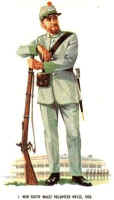 |
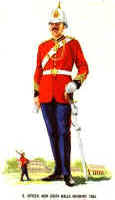 |
| NEW
SOUTH WALES VOLUNTEER RIFLES, 1855 |
Officer
NEW SOUTH WALES INFANTRY, 1885 |
1st NSW RIFLE VOLUNTEERS,
1854-1860
In 1851, the Government of NSW, with the
sanction of HM Imperial Government, authorised the establishment of
Volunteer Corps in Sydney. Three years later in September 1854, during
the Crimean War, the 1st NSW Rifle
Volunteers was formed. It is from this Regiment that the present Unit
claims direct decent. The first Commanding officer was Major Thomas Wingate.
The original uniform was a dark green frockcoat with black velvet
facings and black shoulder straps with trousers of similar material with
a black bold stripe. A forage cap to match was worn with a numeral one
and a bugle as a badge. The first known public appearance of the
Regiment was on the occasion of the opening of an Industrial Exhibition
at the Museum, when it formed a guard of honour for the Governor (Sir
Charles Fitzroy). The Regiment also formed a Guard of Honour for the
Governor at the opening of the Railway to Parramatta and attended the
Queen's Birthday Review on which occasion they were brigaded with the
Dorsetshire Regiment. Public interest in the Volunteer Regiment was
slight and for some years the unit struggled for existence.

THE SYDNEY BATTALION 1860 – 1878
In 1869, during the Maori War in New
Zealand, enthusiasm in the Regiment was revived as a result of public
meetings and under the new title of "The Sydney Battalion" a
considerable number of recruits were enlisted. At this time a change in
the uniform was made, the newly adopted dress being grey with black
facings, an infantry shako and brown belt. On 18th
May, 1861, Lady Young, on behalf of the ladies of Sydney, presented the
Regiment with its first Colours. In 1868, the regiment took part in The
Review before HRH The Duke of Edinburgh. Shortly afterwards, an attempt
was made on the Prince's life which caused great excitement in Sydney.
As a result the Regiment had to supply many guards on public places.
Another change was made to the uniform the following year, when scarlet
tunics, dark blue trousers with scarlet piping were adopted. The shako
was retained but some years later was replaced with a white helmet. The
first volunteer encampment for continuous training in New South Wales
was conducted during Easter 1873, at Ham Common near Richmond.
Subsequent camps were held in the Campbelltown area.
THE FIRST REGIMENT INFANTRY 1878 – 1911
In 1878 a system of partial payment for
volunteers was approved and the Sydney Battalion was absorbed into the
First Regiment Infantry. During the peaceful years that followed, the
purely metropolitan nature of the unit was extended to include companies
at Goulburn, Wagga Wagga, Moss Vale & Mudgee. In 1885 a detachment
of one officer and 75 other ranks from the First Regiment sailed with
the contingent for the Soudan, the first occasion on which Australian
troops served abroad. Although the contingent arrived in South Africa
towards the end of the campaign, their activities were recognised by the
inclusion in the First Regiment's Battle Honour of
Towards the end of the century the
uniform was changed to khaki, although the scarlet uniform was retained
for ceremonial purposes. The Regiment contributed twelve officers and
ninety-one other ranks to the contingents which participated in the
South African War. Major Watson, a member of the First Regiment, was the
officer selected to demand the surrender of Pretoria. Private (later
Captain) Dufrayer was awarded one of the four scarves knitted by HM
Queen Victoria as an award for special gallantry.
was added to the Regimental Battle
Honours. In 1905, Lord Northcote, the Governor General and Honorary
Colonel of the Regiment, presented Colours which subsequently were
deposited in the Chancel of St Andrew's Cathedral, Sydney. In 1911 with
the introduction of universal training, there was a change in the
designation to 21, 24 and 26 Regiment.
THE GREAT WAR
Although records are incomplete, it is
known that more than 100 officers who had trained with the pre-war First
Regiment saw service in various AIF units. Among them were Major General
Holmes, Brigadier General McLaurin, Brigadier General S.C. Herring,
Brigadier General I. C. McKay, Brigadier General J. Heane. The history
of the 1st Battalion during world war
one is a history in itself. The Battalion sailed from Australia with the
first contingent in 1914 and served with distinction at Gallipoli and in
France.
Three Victoria crosses are among the
many decorations awarded to members of the 1st
Battalion, AIF. The recipients were; Lance Corporal L. Keysor, Captain
A.J. Shout and Corporal G.J. Howell.
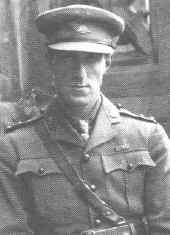 |
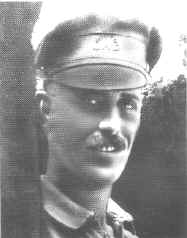 |
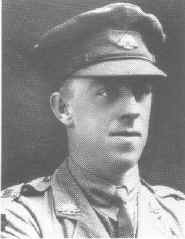 |
| Keysor
VC |
Shout
VC |
Howell
VC |
THE FIRST BATTALION (EAST SYDNEY REGIMENT) 1919 – 1944
In the years between the
wars the Regiment was linked with a number of other Battalions and was
known under various titles.
However it always reverted to the title granted in 1921, "The First
Battalion East Sydney Regiment". In 1937 the City of Sydney by
charter adopted the Battalion as "The City of Sydney Regiment"
and at the outbreak of World War II the full title was "1st
Battalion, City of Sydney Regiment".
1st/19th
BATTALION CITY OF SYDNEY REGIMENT
On 1st July 1930 the 1st
Battalion was amalgamated with the 19th
Battalion under the title 1st/19th
Battalion. Lieutenant Colonel C.H. Howard, OBE, VD was appointed the
first Commanding Officer and he remained in command until 1st
July 1934.
THE SECOND WORLD WAR 1939-1945
Prevailing policy at the time prevented
units of the pre-war militia serving abroad. However a great many
officers, NCO's and men of the pre-war 1st
Battalion served with the three services during World War II. The
Regiment was known under a variety of titles until it was disbanded in
1944. The 2nd/1st
Infantry Battalion of the Second AIF served with distinction in the
Middle East and Pacific Theatres. It participated in the first offensive
on Libya, the defence of Greece and Crete, where the Battalion earned
fame at Retimo. After its return to Australia in 1942 it moved to New
Guinea where it participated in the advance across the Kokoda trail and
the battle for Gona. In 1944 – 45 it took part in the Aitape – Wewak
campaign and was engaged in active operations when the war ended in
August 1945. The following officers commanded the Battalion: Major
General P.A. Cullen, AC, CBE, DSO, ED; Major General I. Campbell, CBE,
DSO; Major General K.W. Eather, CB, CBE, DSO, ED, Colonel T. White.
THE FIRST INFANTRY BATTALION (Commando) CITY OF SYDNEY'S OWN
REGIMENT
When the post war CMF came into being in
1948, the 1st Battalion was not
re-formed. On the 25th June 1955 the 1st
Commando Company was raised in Eastern Command. In 1957 it was decided
that as this unit already incorporated the designation "1st"
within it's title it would be a convenient framework on which to reform
the old 1st Battalion. Accordingly on
the 1st of December 1957 the unit was
re-designated as 1st Infantry
Battalion (Commando) City of Sydney's Own Regiment. The 1st
Battalion City of Sydney's Own Regiment was granted Freedom of the City
for Entry by the City of Sydney on 10th
October 1959. This honour conferred the privilege on the unit of being
able to "march through the streets with bayonets fixed, drums
beating, bands playing and Colours flying." When the Citizens
Military Forces were re-organized on 1st
July 1960 the unit became the 1st
Battalion The Royal New South Wales Regiment. On 16th
October 1965 His Excellency Sir Roden Cutler, VC, AK, KCMG, KCVO, CBE,
Honorary Colonel of the Royal New South Wales Regiment presented new
Queen's and Regimental Colours to the unit.
19th AUSTRALIAN INFANTRY REGIMENT
This unit was formed in 1913 from
elements of the 1st and 3rd
Regiments and later in the same year, from part of the 18th
Regiment. The new Regiment was based on the upper North Shore area of
Sydney. In 1914 it was designated the 19th
(Ku-ring-gai) Infantry Regiment. Upon the outbreak of the First World
War it was decided that the existing units would not be sent overseas,
and that a separate expeditionary force, the Australian Imperial Force
(AIF) would be raised for that purpose. At the end of the war it was
decided to incorporate the Battalions of the AIF within existing
regiments forming the permanent establishment of the Australian Army, as
1st (Inactive) Battalion in each case.
This re-organisation required the relocation of some units and the
re-numbering of others. 19th Regiment
was southern side of the harbour was re-designated as 19th
Regiment. This began the long association of the unit with the South
Sydney area.
19th INFANTRY BATTALION (THE SOUTH
SYDNEY REGIMENT)
Arising from the Monash report of 1921
the Army was re-organised upon the divisional system of the AIF. This
necessitated the reversion of regiments containing a number of
battalions, to the single battalion system. 19th
Australian infantry Regiment was re- designated 19th
Infantry Battalion and part of 1st
Infantry Regiment was incorporated in the new unit. Authority to carry
King's and Regimental Colours was granted to all battalions of the AMF
in 1923. The King's and Regimental Colours of the 19th
Battalion were presented tot he Battalion (then commanded by Major J.M.
Maughan, DSO) by the Governor of New South Wales at a parade held at
Liverpool camp on 22nd March,
1925.
Authority to inherit Battle Honours
awarded to the 19th Battalion AIF was
granted in 1927, and in the same year, the motto "FORTITER
ET FIDELITER" (Boldly and Faithfully) and the Territorial
Title "The South Sydney Regiment" were authorized. Drastic
cuts imposed upon the Army by the Great Depression resulted in the
decision to link 19th with 1st
Battalion, as 1/19th Battalion. This
link was severed on the eve of the Second World War, when 1st
Battalion was re-constituted. On the same day, 1st
September, 1939, 19th was linked with
20th Battalion as 20/19th
Battalion.
As the Japanese threat became more
apparent the defences of Darwin were strengthened by the raising of the
Darwin Infantry Battalion, which in November, 1941, was re-designated as
19th Infantry Battalion. The Battalion
remained in Darwin through the period of the heavy air raids, until
1942. In July, 1943 the 19th Battalion
moved to New Guinea in a defence role, moving finally to New Britain in
December, 1944. From then until April, 1945, it maintained close contact
with the Japanese in the Wide Bay area. 19th
Battalion returned to Brisbane, where it was disbanded in July, 1945, to
provide reinforcement drafts.
During the period of its service in New
Guinea, the Battalion became an AIF unit, and was designated 19th
Australian Infantry Battalion (AIF). For its service in the South West
Pacific area the Battalion was granted the following Battle Honours:
These Honours were inherited by the 19th
Battalion (although not raised at the time) in 1961. The unit was not
among those raised in 1948, when the Citizen Military Forces was
re-constituted on a restricted establishment.
19th BATTALION AIF
The 19th
Battalion AIF was formed on 27th April, 1915, by Lieutenant Colonel
W.K.S. MacKenzie, DSO, VD a Sydney barrister and former Commanding
Officer of the 25th Infantry, as a
unit of the 5th Infantry Brigade,
Second Australian Division. After training in Egypt the Battalion
arrived at ANZAC cove on 21st August
1915 and entered the line at Hill Sixty the following day. From the 18th
September until the evacuation the unit was responsible for the
defence of Popes Hill, one of the most critical points in the ANZAC
defence system. After re-organisation in Egypt 19th Battalion was moved
to France early in 1916. The first major action for the Battalion was Pozieres
which was notable for the fact that the German shelling was the most
intense ever experienced by the AIF during the war and was accompanied
by nearly continuous German counter attacks to recover their vital
ground. 19th Battalion created a
record by holding its sector for a period of 12 days. Casualties
suffered by 1 ANZAC Corps in this battle amounted to 23,000 over a
period of about 40 days. Possibly the most notable action of the 19th
Battalion was it's capture and defence of the notorious 'Maze' defence
system at Flers on 14th November 1916.
The failure of flanking Battalions to reach their objectives left the
unit out on its own, holding a salient deep within the German lines.
For two days and nights the 19th
Battalion held this position against counter attacks and intense
shelling, using German weapons so that their own .303 ammunition could
be used to maintain their Lewis guns in action. Of the 451 all ranks who
went into the attack, 381 became casualties. Other notable actions were
at Second Bullecourt and at Third Ypres. It was towards the end of this
latter battle that the Commanding Officer, Lieutenant Colonel C.R.A.
Pye, DSO was killed in action on 4th
October 1917. Moved from the Messines area as a result of the great
German break through on the Fifth Army front, 19th
Battalion entered the line near Villers-Bretonneux on 6th
April 1918.
The next day the unit launched a counter
attack upon German positions in Hangard Wood and during the course of
this action
Lieutenant P. V. Storkey won the Victoria Cross for a daring series of
acts which enabled the attack to succeed. 19th
Battalion was constantly in the line during the period prior to the
great British offensive, which was spearheaded by the Australian and
Canadian Corps in the Amiens sector, on the 8th
August 1918. This action was described by the German commander,
Ludendorff, as "the black day of the German Army" and on this
day and the days that followed as the German Army retreated fighting
tenaciously for every position, 19th
Battalion played an effective part.
During the great advance to the Hindenburg
Line 19th Battalion, as part of the 5th
Brigade, rushed the great fortress area of Mont St Quentin which was
defended by the Prussian Guards. General Rawlinson, commanding the
British Fourth Army, described this as the "finest single feat of
the war". The last action fought by the Battalion was the capture
of the Beaurevoir Switch Line which breached the great Hindenburg line
on 4th October 1918. The Australian
Corps was then withdrawn for rest and re-organisation, which involved
the disbandment of that Battalion in each Brigade which was numerically
the weakest in order that the remaining Battalions could be brought up
to strength. On the 10th October 1918
the 19th Battalion was one of eleven
Battalions of the AIF to suffer this unhappy fate. Throughout the war
the Battalion suffered 3,333 casualties.
For its service in the First World War the
19th Battalion AIF was granted 20 Battle
Honours which were inherited in 1927 by 19th Battalion
(The South Sydney Regiment). The Honours are:
- SOMME 1916-18
- POZIERES
- BAPUME
- BULLECOURT
- YPRES 1917
- MENIN ROAD
- POLYGON WOOD
- BROODSEINDE
- POELCAPPELLE
- PASSCHENDAELE
|
- HAMEL
- AMIENS
- ALBERT 1918
- MONT ST QUENTIN
- HINDENBURG LINE
- BEAUREVOIR
- FRANCE AND FLANDERS 1916-18
- SUVLA
- GALLIPOLI
- EGYPT 1915-16
|
The following officers commanded the
Battalion: Lieutenant Colonel W.K.S. MacKenzie DSO VD, Lieutenant Colonel
H. Beiers MC, Major J.M. Maugham DSO, Major W.J.R. Scott DSO, Lieutenant
Colonel C.R.A. Pye DSO, Major J.J. Walker, Lieutenant Colonel W.J.
Bateman, Major S. Middleton DSO.
The last appearance of the 19th
Battalion AIF was the great parade held in the Sydney Domain on 14th
August 1920 when representatives of the old Battalion (in company with
parties from each of the AIF Infantry Battalions raised in New South
Wales) received the Union Flag presented to them on behalf of HM King
George V. This was then placed in the custody of the 19th
Battalion, AMF, there present with its sister battalions on
parade for this purpose. This flag was subsequently converted into a
Kings colour for the 19th Battalion,
AMF.
2nd/ 19th
AUSTRALIAN INFANTRY BATTALION AIF
On 15th
July, 1940, the officers and NCO's of the 2nd/19th
Infantry Battalion went into camp at Wallgrove, NSW and within a few
days the new battalion began to receive drafts. The unit was part of the
22nd Infantry Brigade of the 8th
Australian Division; its first Commanding Officer being Lieutenant
Colonel D. S Maxwell, MC. On 22nd
February, 1941, 22nd Brigade arrived
in Singapore and shortly afterwards moved up country into the jungles of
Malaya, where intensive training in jungle warfare was carried out in
the months remaining before the Japanese attack.
A platoon of 2nd/19th
had the distinction of being the first Australian Infantry to engage the
enemy at the village of Trong, in northern Malaya, on 27th
December, 1941. On 18th January, 1942,
2nd/19th
Battalion occupied the Baki area in the Muar sector, where contact was
made with the advancing Japanese on the same day. As a part of the force
holding the Western Trunk road, the Battalion went into action against
the Japanese Guard Division the following day, and scored a series of
significant successes against the enemy who were not expecting his
opponents to show any proficiencies in jungle tactics.
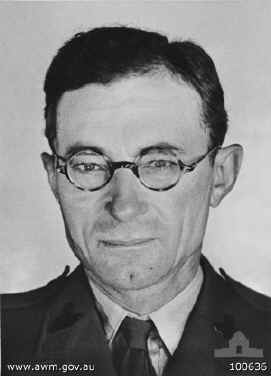 |
The necessity to
conform to the movement of other forces, and the continued cutting
of the Trunk road to the rear by the Japanese, made it necessary
to commence withdrawal. In a series of fierce actions, from Bakri
to the bridge at Parit Sulong, which was held by the Japanese, the
Battalion fought its way clear of the closing trap.
For his gallantry during this period, the
Commanding Officer,
<< Lieutenant
Colonel C.G.W Anderson, VC, MC, was awarded the Victoria
Cross. |
After re-grouping and further actions in
the Johore state, 2/19th Battalion
moved to Singapore Island, where it took place in the defence of the
Island, from 8th February, 1942, until
the capitulation on 15th February
1942. Thereafter the Battalion passed into captivity with the remainder
of the British Forces, in the general surrender. For its gallant work in
Malaya, 2/19th Battalion AIF was
awarded the following Battle Honours;
-
SINGAPORE
ISLAND;
-
THE
MUAR;
-
MALAYA
1941-42.
These honours were inherited by the 19th
Battalion (although not raised at that time) in 1961.

|
|
